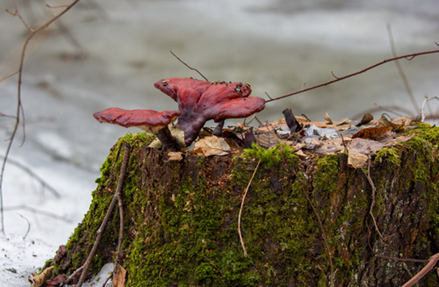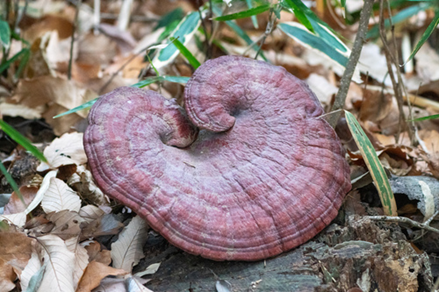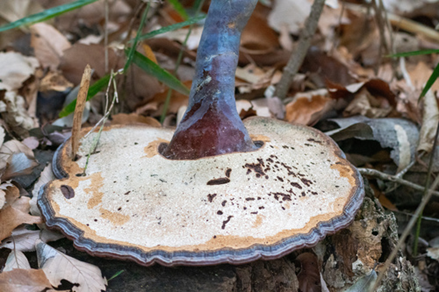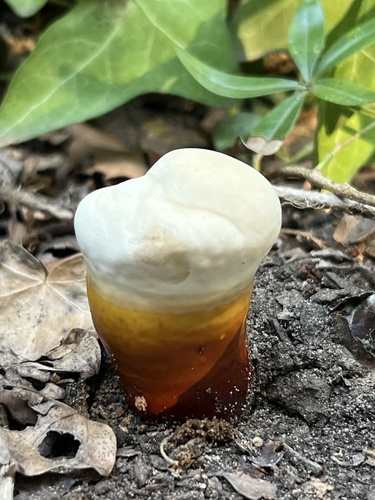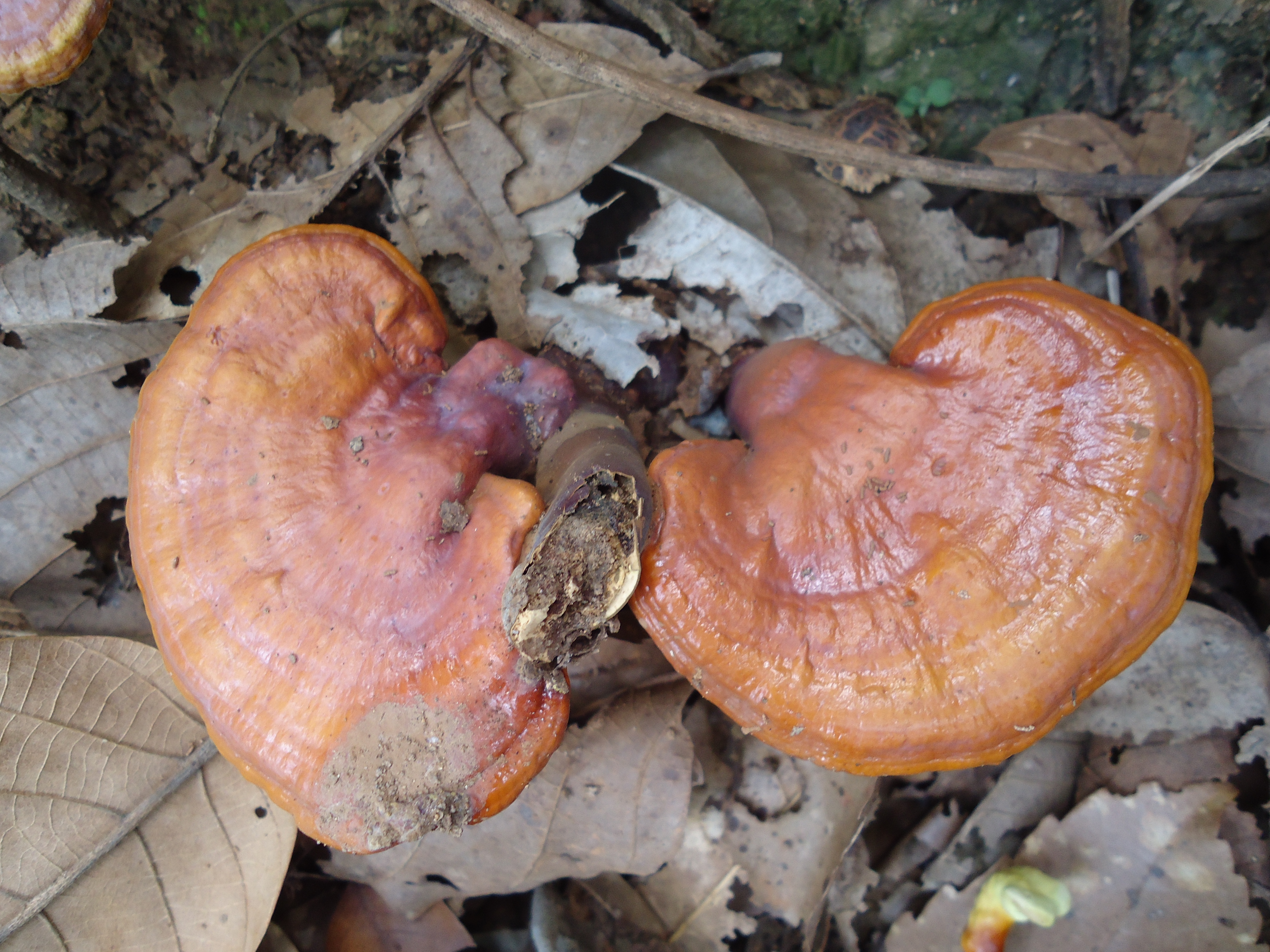ເລກລຳດັບທີ: 137
ລະດັບການຮວບຮວມຂໍ້ມູນ: ຂໍ້ມູນພື້ນຖານ
ປັບປູງຄັ້ງລ່າສຸດ: 2025-04-08
ເຫັດລິນຈື່
Lizing Mushroom
Ganoderma lucidum (Curtis) P.Karst.
ເຊື້ອເຫັດ
ເຊື້ອຣາເກີດຕາມໄມ້
×
ຊື່ທ້ອງຖີ່ນ:
ເຫັດກ້ານຈອງ ( Lacquered Bracket)
ຊື່ພ້ອງ
:
Agarico-igniarium trulla Paulet
Agaricus lignosus Lam.
Agaricus pseudoboletus Jacq., 1778
Boletus castaneus Weber
Boletus crustatus J.J.Planer
Boletus flabelliformis Leyss.
Boletus laccatus Timm
Boletus lucidus Curtis
Boletus ramulosum subsp. flabelliformis (Leyss.) J.F.Gmel., 1792
Boletus ramulosum var. flabelliformis (Leyss.) J.F.Gmel.
Boletus rugosus Jacq.
Boletus supinus J.F.Gmel.
Boletus supinus subsp. castaneus (Weber) J.F.Gmel., 1792
Boletus supinus var. castaneus (Weber) J.F.Gmel.
Boletus verniceus Brot.
Boletus vernicosus Bergeret
Fomes amboinensis var. japonicus (Fr.) Cooke
Fomes japonicus (Fr.) Sacc.
Fomes lucidus (Curtis) Cooke
Fomes lucidus (Curtis) Fr.
Fomes lucidus (Curtis) Sacc.
Fomes lucidus var. badius (Pat.) Sacc. & P.Syd.
Fomes lucidus var. exquisitus (Kalchbr.) F.M.Bailey
Fomes lucidus var. nicotianae (Inglese) Sacc. & Traverso
Fomes lucidus var. resinosus Pat.
Fomes lucidus var. resinosus Pat. ex Rick
Fomes resinaceus var. martellii (Bres.) Sacc.
Ganoderma japonicum (Fr.) Sawada
Ganoderma laccatum (Timm) Pat.
Ganoderma lucidum f. alneum Bourdot & Galzin
Ganoderma lucidum f. annulatum Torrend
Ganoderma lucidum f. boninense Pat.
Ganoderma lucidum f. hemisphaericum Torrend
Ganoderma lucidum f. martellii (Bres.) Bourdot & Galzin
Ganoderma lucidum f. naiae Chona & Munjal
Ganoderma lucidum f. noukahivense Pat.
Ganoderma lucidum f. rubellum Torrend
Ganoderma lucidum var. badium Pat.
Ganoderma lucidum var. japonicum (Fr.) Bres.
Ganoderma lucidum var. nicotianae (Inglese) Sacc. & Trotter
Ganoderma lucidum var. orbiformis Steyaert
Ganoderma lucidum var. resinaceum Maire
Ganoderma lucidum var. resinosum Pat.
Ganoderma mongolicum Pilát
Ganoderma nitens Lázaro Ibiza
Ganoderma ostreatum Lázaro Ibiza
Ganoderma ostreatum var. hemicycla Lázaro Ibiza
Ganoderma pseudoboletus (Jacq.) Murrill
Ganoderma resinaceum var. martellii Bres.
Grifola lucida (Curtis) Gray
Phaeoporus lucidus (Curtis) J.Schröt.
Placodes lucidus (Curtis) Quél.
Polyporites lucidus (Curtis) Mesch.
Polyporus japonicus Fr.
Polyporus laccatus (Timm) Pers.
Polyporus laccatus subsp. laccatus (Timm) Pers.
Polyporus laccatus subsp. semipatera Pers.
Polyporus lucidus (Curtis) Fr.
Polyporus lucidus subsp. japonicus Fr.
Polyporus lucidus var. exquisitus Kalchbr.
Polyporus lucidus var. japonicus (Fr.) Cleland & Cheel
Polyporus lucidus var. nicotianae Inglese
Pyrenium vernicosum (Bergeret) Paulet
Scindalma japonicum (Fr.) Kuntze
Agaricus lignosus Lam.
Agaricus pseudoboletus Jacq., 1778
Boletus castaneus Weber
Boletus crustatus J.J.Planer
Boletus flabelliformis Leyss.
Boletus laccatus Timm
Boletus lucidus Curtis
Boletus ramulosum subsp. flabelliformis (Leyss.) J.F.Gmel., 1792
Boletus ramulosum var. flabelliformis (Leyss.) J.F.Gmel.
Boletus rugosus Jacq.
Boletus supinus J.F.Gmel.
Boletus supinus subsp. castaneus (Weber) J.F.Gmel., 1792
Boletus supinus var. castaneus (Weber) J.F.Gmel.
Boletus verniceus Brot.
Boletus vernicosus Bergeret
Fomes amboinensis var. japonicus (Fr.) Cooke
Fomes japonicus (Fr.) Sacc.
Fomes lucidus (Curtis) Cooke
Fomes lucidus (Curtis) Fr.
Fomes lucidus (Curtis) Sacc.
Fomes lucidus var. badius (Pat.) Sacc. & P.Syd.
Fomes lucidus var. exquisitus (Kalchbr.) F.M.Bailey
Fomes lucidus var. nicotianae (Inglese) Sacc. & Traverso
Fomes lucidus var. resinosus Pat.
Fomes lucidus var. resinosus Pat. ex Rick
Fomes resinaceus var. martellii (Bres.) Sacc.
Ganoderma japonicum (Fr.) Sawada
Ganoderma laccatum (Timm) Pat.
Ganoderma lucidum f. alneum Bourdot & Galzin
Ganoderma lucidum f. annulatum Torrend
Ganoderma lucidum f. boninense Pat.
Ganoderma lucidum f. hemisphaericum Torrend
Ganoderma lucidum f. martellii (Bres.) Bourdot & Galzin
Ganoderma lucidum f. naiae Chona & Munjal
Ganoderma lucidum f. noukahivense Pat.
Ganoderma lucidum f. rubellum Torrend
Ganoderma lucidum var. badium Pat.
Ganoderma lucidum var. japonicum (Fr.) Bres.
Ganoderma lucidum var. nicotianae (Inglese) Sacc. & Trotter
Ganoderma lucidum var. orbiformis Steyaert
Ganoderma lucidum var. resinaceum Maire
Ganoderma lucidum var. resinosum Pat.
Ganoderma mongolicum Pilát
Ganoderma nitens Lázaro Ibiza
Ganoderma ostreatum Lázaro Ibiza
Ganoderma ostreatum var. hemicycla Lázaro Ibiza
Ganoderma pseudoboletus (Jacq.) Murrill
Ganoderma resinaceum var. martellii Bres.
Grifola lucida (Curtis) Gray
Phaeoporus lucidus (Curtis) J.Schröt.
Placodes lucidus (Curtis) Quél.
Polyporites lucidus (Curtis) Mesch.
Polyporus japonicus Fr.
Polyporus laccatus (Timm) Pers.
Polyporus laccatus subsp. laccatus (Timm) Pers.
Polyporus laccatus subsp. semipatera Pers.
Polyporus lucidus (Curtis) Fr.
Polyporus lucidus subsp. japonicus Fr.
Polyporus lucidus var. exquisitus Kalchbr.
Polyporus lucidus var. japonicus (Fr.) Cleland & Cheel
Polyporus lucidus var. nicotianae Inglese
Pyrenium vernicosum (Bergeret) Paulet
Scindalma japonicum (Fr.) Kuntze
ຊື່ສະກຸນ:
Polyporaceae
ຊະນິດໃກ້ຄຽງ:
ບັນຍາຍລັກສະນະທາງພືດສາດ:
ກ້ານເຫັດຈັບດ້ານຂ້າງ ແລະ ມີສີນ້ຳຕານປົນແດງມ ຮາກຈະຝັງລົງໃນດິນ ແລະ ມີຄວາມຍາວລະຫວ່າງ 60 ຫາ 75 ມມ., ສູງສຸດຮອດ 200 ມມ. (ໃນບາງກໍລະນີ) ມີເສັ້ນຜ່າສູນກາງ 9 ຫາ 12 ມມ.
ເຫັດຊະນິດນີ້ມີລັກສະນະເປັນມັນເງົາ ແລະ ມີລັກສະນະເປັນຮູບໝາກໄຂ່ຫຼັງ ຫຼື ຮູບເຄິ່ງວົງກົມທີ່ໂດດເດັ່ນ, ໂດຍມີກ້ານດອກທີ່ຊັດເຈນ, ຜິວດ້ານເທິງມີການໄລ່ເສດສີທີ່ສວຍງາມ ໂດຍຈະເລີ່ມຈາກສີນ້ຳຕານແດງບໍລິເວນໃກ້ກ້ານດອກ, ຈາກນັ້ນຈະເປັນສີນ້ຳຕານແດງ ແລະ ປເປັນສີນ້ຳຕານແດງບໍລິເວນໃກ້ຂອບ ແລະ ມີຂອບມີສີຄີມ ໄປຈົນຮອດສີເຫຼືອງອ່ອນ.
ດ້ານລຸ່ມຂອງໝວກເຫັດມີຮູພຸນຂະໜາດນ້ອຍ ໂດຍສະເລ່ຍ 4 ຫາ 5 ຮູຕໍ່ມິນລີແມັດ, ຮູພຸນເຫຼົ່ານີ້ມີສີຂາວໄປຈົນຮອດສີເຫຼືອງ ແລະ ເມື່ອຂູດອອກຈະເຂັ້ມຂື້ນ.
ເນື້ອເຫັດຊັ້ນກາງມີສີເທົາເຂັ້ມຈົນຮອດສີນ້ຳຕານ, ເຮັດໃຫ້ເບິ່ງສວຍາມຫຼາຍຂື້ນ.
ແຫຼ່ງທີ່ມາ: [1]
ເຫັດຊະນິດນີ້ມີລັກສະນະເປັນມັນເງົາ ແລະ ມີລັກສະນະເປັນຮູບໝາກໄຂ່ຫຼັງ ຫຼື ຮູບເຄິ່ງວົງກົມທີ່ໂດດເດັ່ນ, ໂດຍມີກ້ານດອກທີ່ຊັດເຈນ, ຜິວດ້ານເທິງມີການໄລ່ເສດສີທີ່ສວຍງາມ ໂດຍຈະເລີ່ມຈາກສີນ້ຳຕານແດງບໍລິເວນໃກ້ກ້ານດອກ, ຈາກນັ້ນຈະເປັນສີນ້ຳຕານແດງ ແລະ ປເປັນສີນ້ຳຕານແດງບໍລິເວນໃກ້ຂອບ ແລະ ມີຂອບມີສີຄີມ ໄປຈົນຮອດສີເຫຼືອງອ່ອນ.
ດ້ານລຸ່ມຂອງໝວກເຫັດມີຮູພຸນຂະໜາດນ້ອຍ ໂດຍສະເລ່ຍ 4 ຫາ 5 ຮູຕໍ່ມິນລີແມັດ, ຮູພຸນເຫຼົ່ານີ້ມີສີຂາວໄປຈົນຮອດສີເຫຼືອງ ແລະ ເມື່ອຂູດອອກຈະເຂັ້ມຂື້ນ.
ເນື້ອເຫັດຊັ້ນກາງມີສີເທົາເຂັ້ມຈົນຮອດສີນ້ຳຕານ, ເຮັດໃຫ້ເບິ່ງສວຍາມຫຼາຍຂື້ນ.
ແຫຼ່ງທີ່ມາ: [1]
ນິເວດວິທະຍາ
ເຂດກະຈາຍພັນທົ່ວໂລກ:
Ganoderma lucidum is primarily native to forests in China and Europe. [2]
ຊະນິດພັນພື້ນໃນປ່າຂອງຈີນ ແລະ ຢູໂຣບ. [2]
Distribution of Ganoderma lucidum between 1800 to 2025. Source: [3]
ເຂດກະຈາຍພັນທົ່ວໂລກຂອງເຫັດລິນຈື ລະຫວ່າງ ປີ 1800 ຫາ 2025. ແຫຼ່ງທີ່ມາ: [2]
ຊະນິດພັນພື້ນໃນປ່າຂອງຈີນ ແລະ ຢູໂຣບ. [2]
Distribution of Ganoderma lucidum between 1800 to 2025. Source: [3]
ເຂດກະຈາຍພັນທົ່ວໂລກຂອງເຫັດລິນຈື ລະຫວ່າງ ປີ 1800 ຫາ 2025. ແຫຼ່ງທີ່ມາ: [2]
ເຂດກະຈາຍພັນໃນລາວ
:
ເຂດພູສູງສາຍພູຫຼວງ ແລະ ເຂດພູພຽງແຂວງຊຽງຂວາງ
ເຂດລຽບແມ່ນ້ຳຂອງພາກໃຕ້
ເຂດລຽບແມ່ນ້ຳຂອງພາກໃຕ້

ເຂດກະຈາຍພັນຕາມພູມສັນຖານ
:
ປ່າປະສົມປ່ຽນໃບ
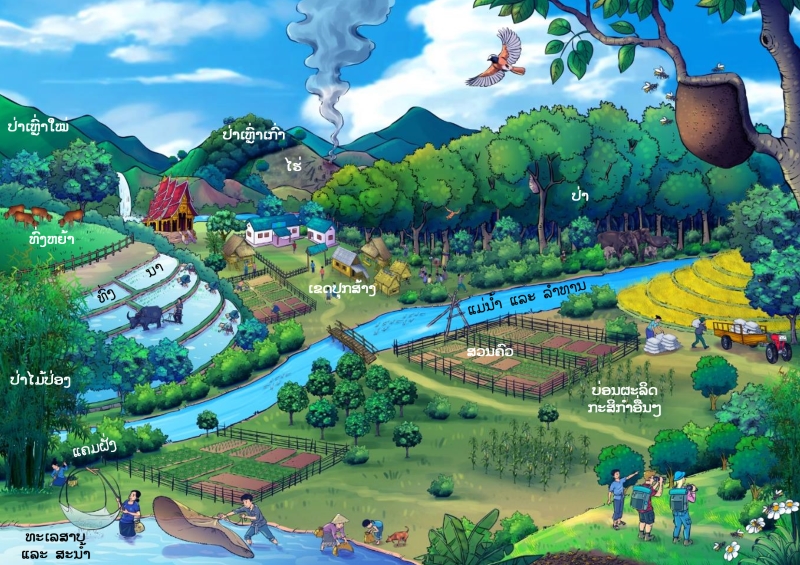
ສະເພາະຖິ່ນໃນລາວ:
ຕ່າງຖິ່ນ
ຮຸກຮານ
:
ບໍ່ຮຸກຮານ
ສະຖານະພາບການອະນູຮັກ IUCN
:
ບໍ່ມີຄວາມສ່ຽງ
ສະຖານະພາບການອະນຸຮັກແຫ່ງຊາດລາວ
:
ບັນຊີທີ່ III: ຊະນິດພັນປະເພດທົ່ວໄປ
ການນຳໃຊ້
ປະເພດການນຳໃຊ້:
ພືດເປັນຢາ
ບັນຍາຍການນຳໃຊ້:
ເຫັດລິນຈຶ່ສາມາດກິນໄດ້ເນື່ອງຈາກມີຄຸນຄ່າທາງດ້ານໂພຊະນາການສູງ ແລະ ມີສ່ວນຊ່ວຍໃຫ້ກິນອາຫານແຊບ, ເຫັດລິນຈື່ມີຄຸນສົບບັດທາງດ້ານການຢາ ລວມທັງມີລິດໃນການຕ້ານມະເຣັງ. [4]
ການປູກ ການລ້ຽງ:
ຊະນິດທຳມະຊາດ
ລະດູການເກັບກູ້:
ການຕະຫຼາດ ແລະ ຕ່ອງໂສ້ມູນຄ່າ:
N/A
ການຄຸ້ມຄອງຈັດການ
N/A
ໂພຊະນາການ
ຄຸນຄ່າທາງໂພຊະນາການ:
ບັນຍາຍຄຸນຄ່າທາງໂພຊະນາການ:
N/A
| ສານອາຫານ | /100g | ໝາຍເຫດ |
|---|---|---|
| ໂປຣຕີນ | N/A | N/A |
| ຄາໂບໄຮເດຣດ | N/A | N/A |
| ໄຂມັນ | N/A | N/A |
| ວິຕາມິນ | N/A | N/A |
| ແຮ່ທາດ | N/A | N/A |
| ເສັ້ນໄຍ | N/A | N/A |
ອ້າງອິງ
ເຄດິດຮູບພາບ:
Young Ganoderma lucidum emerges from the woody. [1] iNaturalist [Online]. Uploaded on March 2024 by: ehorosho. Available: https://www.inaturalist.org/photos/367454165. [Accessed: 05 October 2024]
The closing up of the Ganoderma lucidum is in full bloom. [2] iNaturalist [Online]. Uploaded on 20 January 2024 by: tbc_watanabe. Available: https://www.inaturalist.org/photos/347162718. [Accessed: 05 October 2024]
The stem and lower or undersides of the Ganoderma lucidum. [3] iNaturalist [Online]. Uploaded on 20 January 2024 by: tbc_watanabe. Available: https://www.inaturalist.org/photos/347162751. [Accessed: 05 October 2024]
Sprout of the Ganoderma lucidum. [4] iNaturalist [Online]. Uploaded on 25 August 2024 by: mibas. Available: https://www.inaturalist.org/photos/423503590. [Accessed: 05 October 2024]
The closing up of the Ganoderma lucidum is in full bloom. [2] iNaturalist [Online]. Uploaded on 20 January 2024 by: tbc_watanabe. Available: https://www.inaturalist.org/photos/347162718. [Accessed: 05 October 2024]
The stem and lower or undersides of the Ganoderma lucidum. [3] iNaturalist [Online]. Uploaded on 20 January 2024 by: tbc_watanabe. Available: https://www.inaturalist.org/photos/347162751. [Accessed: 05 October 2024]
Sprout of the Ganoderma lucidum. [4] iNaturalist [Online]. Uploaded on 25 August 2024 by: mibas. Available: https://www.inaturalist.org/photos/423503590. [Accessed: 05 October 2024]
ອ້າງອິງ:
[1] T. Laessoe and et al., "An Introduction to the Edible, Poisonous and Medical Fungi of Northern Laos," Agro-Biodiversity Project, 2018
[2] "Species Spotlight: Reishi," North Spore, [Online]. Available: https://northspore.com/blogs/the-black-trumpet/species-spotlight-reishi. [Accessed: Apr. 07, 2025].
[3] Global Biodiversity Information Facility (GBIF), “Ganoderma lucidum (Curtis) P.Karst.,” [Online]. Available: https://www.gbif.org/species/2549730. [Accessed: 05 October 2024]
[4] "Mushroom Brochure," Pha Khao Lao, Sep. 2024. [Online]. Available: https://phakhaolao.la/wp-content/uploads/2024/09/mushroom-brochure_final.pdf. [Accessed: Apr. 07, 2025].
[5] "Biodiversity of Lao PDR," National Institute of Biological Resources (NIBR), [Online]. Available: https://www.nibr.go.kr/aiibook/catImage/56/Biodiversity%20of%20Lao%20PDR.pdf. [Accessed: Apr. 07, 2025].
[2] "Species Spotlight: Reishi," North Spore, [Online]. Available: https://northspore.com/blogs/the-black-trumpet/species-spotlight-reishi. [Accessed: Apr. 07, 2025].
[3] Global Biodiversity Information Facility (GBIF), “Ganoderma lucidum (Curtis) P.Karst.,” [Online]. Available: https://www.gbif.org/species/2549730. [Accessed: 05 October 2024]
[4] "Mushroom Brochure," Pha Khao Lao, Sep. 2024. [Online]. Available: https://phakhaolao.la/wp-content/uploads/2024/09/mushroom-brochure_final.pdf. [Accessed: Apr. 07, 2025].
[5] "Biodiversity of Lao PDR," National Institute of Biological Resources (NIBR), [Online]. Available: https://www.nibr.go.kr/aiibook/catImage/56/Biodiversity%20of%20Lao%20PDR.pdf. [Accessed: Apr. 07, 2025].
ຜູ້ສ້າງ Factsheet:
ຜູ້ກວດສອບ Factsheet:
,
